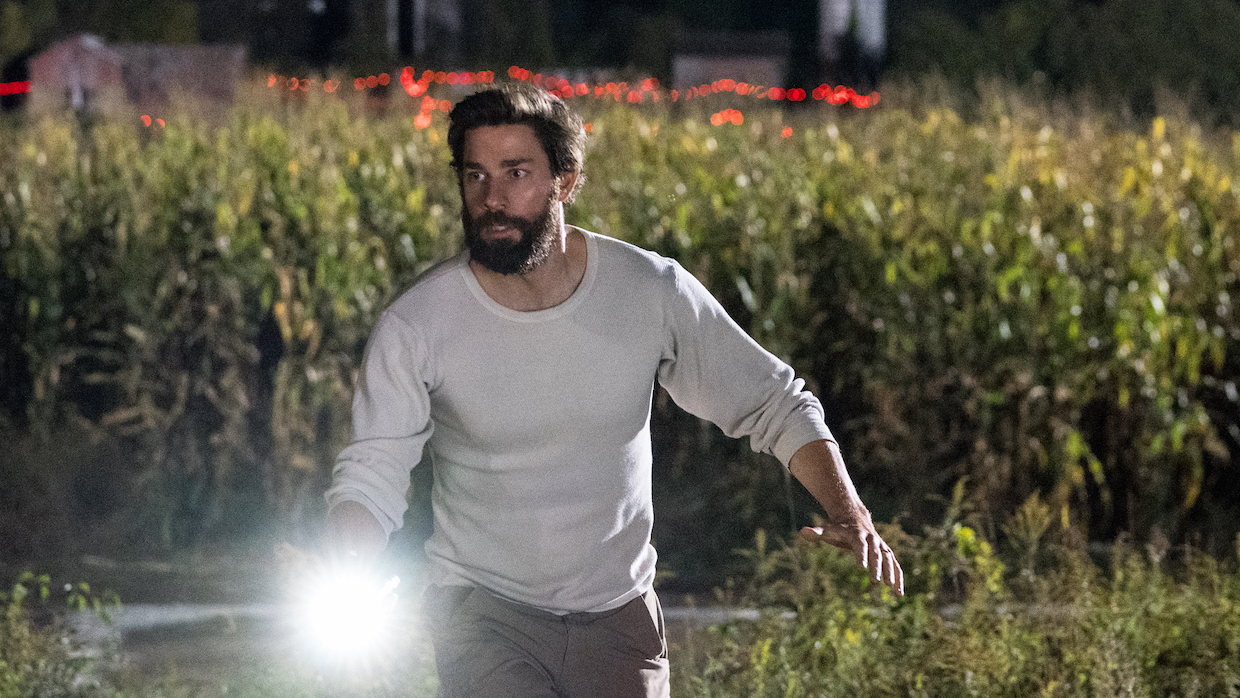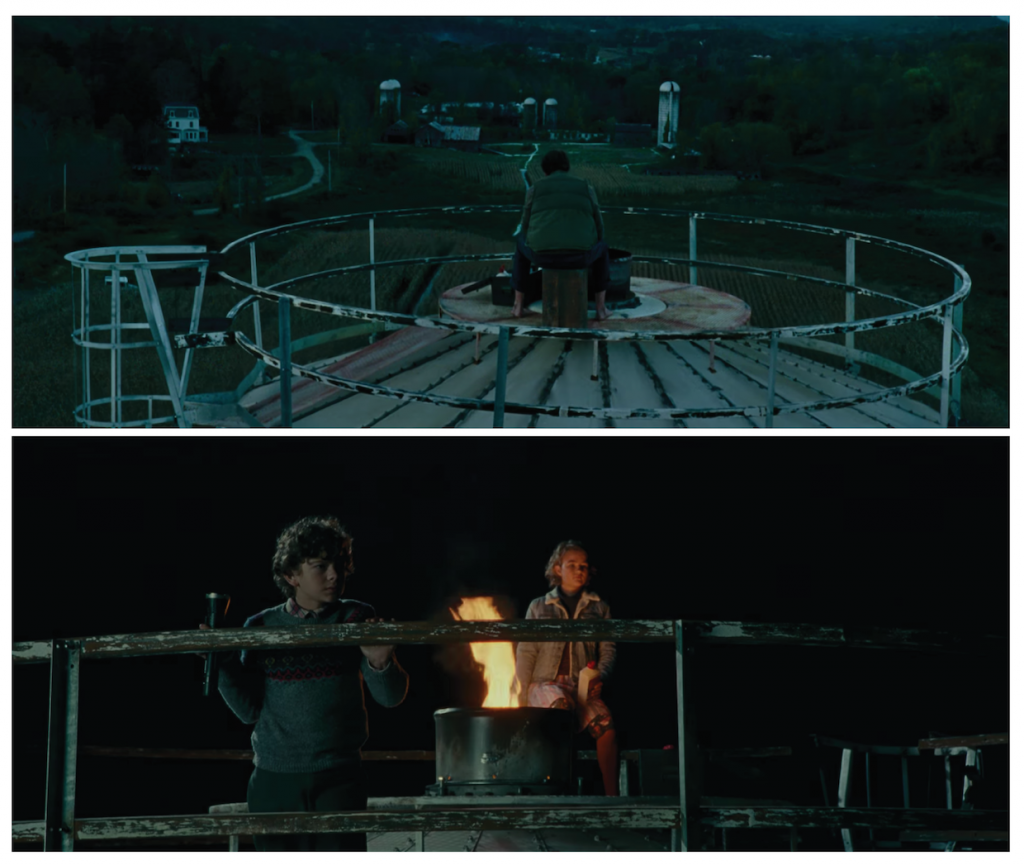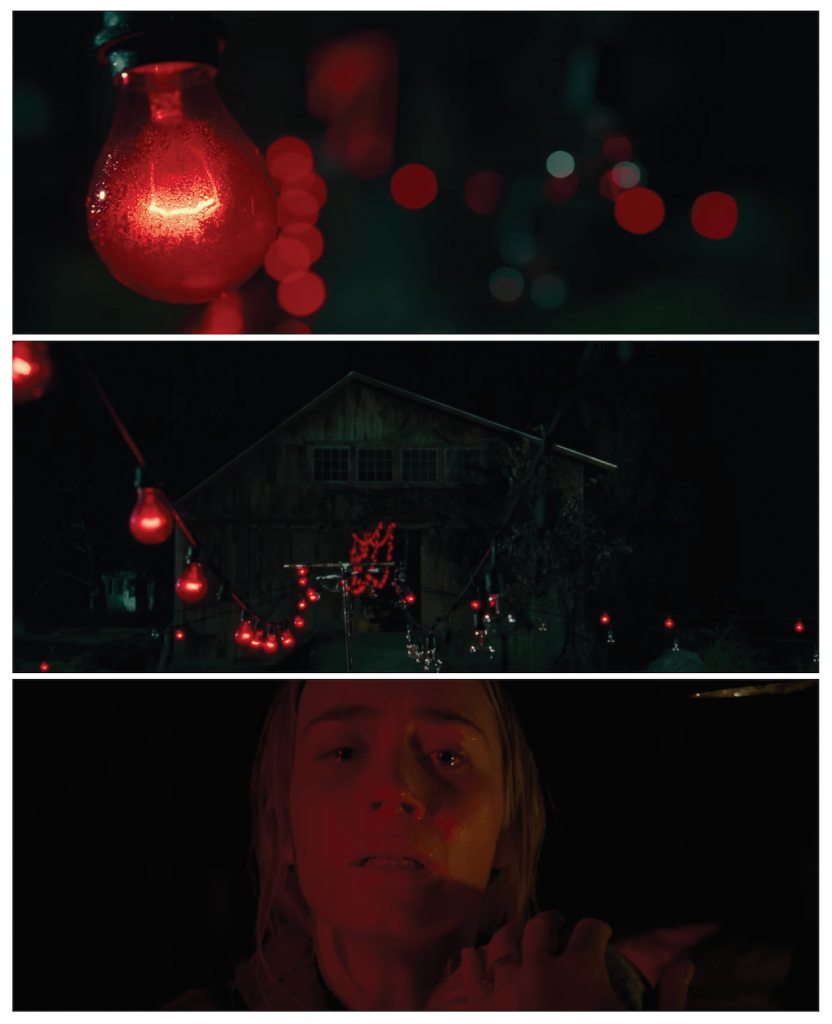 Back to selection
Back to selection
Shutter Angles
Conversations with DPs, directors and below-the-line crew by Matt Mulcahey
“A Very Old Fashioned Kind of Filmmaking”: DP Charlotte Bruus Christensen on Shooting A Quiet Place on 35mm
 John Krasinski in A Quiet Place (Photo by Jonny Cournoyer, copyright Paramount Pictures)
John Krasinski in A Quiet Place (Photo by Jonny Cournoyer, copyright Paramount Pictures) A few months after my son was born, I took my wife to see the Tommy Lee Jones western The Homesman. If you know that movie, then you know why it was a bad idea: minutes into the film, a woman driven mad by the harshness of pioneer life kills her infant child. My wife nearly walked out.
I didn’t understand that impulse at the time, but as my kid has gotten older I’ve become equally squeamish toward onscreen violence directed at children. It’s not an uncommon sentiment for parents, which is why it’s a perilous choice to open the new horror film A Quiet Place with an unexpected act of violence toward a young child. Any film that does such a thing cavalierly for mere shock value is going to lose me instantly. But while that violent moment is shocking in A Quiet Place, that’s not its purpose. It’s intended to establish the dire stakes in this story of a family struggling to survive on their isolated farm in an apocalyptic world overrun by creatures that hunt based on sound vibrations. And it’s intended to set up the theme at the heart of A Quiet Place — the paralyzing parental fear of keeping ones children safe.
I first saw the movie on opening night at last month’s South by Southwest Film Festival and instantly placed it alongside It Follows and Don’t Breathe as one of my favorite horror efforts of the last five years. Like those movies, it works on multiple levels. The subtext is there if you want to wallow in the abject terror of being wholly responsible for a tiny person’s survival. If not, there’s plentiful jump scares and expertly designed set pieces lensed by cinematographer Charlotte Bruus Christensen to entertain you.
The Danish DP is best known for prestige dramas such as Fences, Molly’s Game and Far From the Madding Crowd, but she’s no stranger to the Spielbergian. Christensen cites Jaws as one of A Quiet Place’s influences and fondly recalls wearing out a VHS copy of Raiders of the Lost Ark growing up. With A Quiet Place still going strong in theaters, Christensen spoke to Filmmaker about the hazards of working with red light, giving the film’s young protagonist her own special lens and shooting film at night even when producers told her she was crazy.
Filmmaker: The two things I know about you from other interviews are that you grew up on a farm in Denmark and that as a kid you started taking still photos with your parents’ camera. What was your access to movies like where you grew up?
Christensen: Going to the cinema was kind of a once-a-year event for my family. We would go when there was something spectacular playing, so it was a real treat.
Filmmaker: Are there movies that stand out from those annual trips to the cinema with your family?
Christensen: Yes, but they were usually very Danish kids movies. Those were the only movies being made in Denmark that actually made it to the cinemas. The American movies were what people went to see when I was growing up. I did love the Steven Spielberg movies. When I was eight or nine years old we recorded Raiders of the Lost Ark on VHS off of the TV and watched it again and again and again. Spielberg was one of the first directors whose name I remembered as kid.
Filmmaker: Who were the first cinematographers whose names you remembered?
Christensen: It would’ve been Vittorio Storaro, Conrad L. Hall and Sven Nykvist. I was probably 16 or 17 when I became aware of Sven Nykvist and really became aware that cinematographer was actually a job and there was somebody who was photographing these movies.
My dad sold one of our farms to a film composer when I was a kid and he had horses. I’m a horse girl, so I started riding with this gentleman and he started explaining to me how you compose music for films. He saw that I was taking photographs with my parents’ camera and he said, “You know that there’s a job where you actually tell stories with a camera?” He was the person who explained the job of a cinematographer to me.
Filmmaker: You shot A Quiet Place on a farm in upstate New York. Tell me about that property.
Christensen: It was really lovely. I felt at home. The first time we were at the location when we were starting to scout it was very snowy. We had to go around on a tractor. I’m very familiar with tractors; that’s what I did when I was a kid, I drove tractors for my pocket money. I’m an outdoor person and a farm girl and I always will be. It was a very calming environment for me. Even our offices were at a huge horse farm next door. We were installed in this enormous stable. I loved it because that’s all I do at home when I’m not shooting — spend time with my horses and my kids. So it suited me well.
(Above) Two scenes set atop the family’s grain silo. The top frame was done practically with actor/director John Krasinski perched on the structure and the cameras placed on cranes. For the bottom frame, the kids were photographed on a six-foot tall replica on stage.
Filmmaker: How much were you able to shoot practically on that main property and what did you have to build as sets?
Christensen: The barn and then everything in the interior of the farmhouse was shot at the practical location, which is most of the movie. There’s very few stage sets. The safe room[(underneath the family’s barn] was a set, and then the interior and the very top of the silo were sets. Actually, when [director and star] John Krasinski is up on top of the silo, we shot that practically. He wanted to go up there for real. We wanted to go on top of it with him and shoot handheld, but there were health and safety issues so we had to work off of two cranes. John was up there when the sun went down and that was his cue to light this fire on top of the silo. So there was a timing issue to get that silhouetted feel and for it to be dark enough for the fire to light his face. To work at that height in a time restricted situation was tricky, but it was worthwhile for sure.
Filmmaker: Then when the kids are up there, it’s a set?
Christensen: For that we had a six feet tall set on stage so the kids were safe. In the beginning we were going to use greenscreen for the background, but we were running out of money because the number of VFX shots were growing. So we had to be creative and we just ended up doing a black space behind them. We hoped to put in a few stars in the sky [in post], but that never happened. So it was just a black background and a little wind machine. It was very simple. We lit it from the floor with lamps on stands.
Filmmaker: You’ve been very loyal to shooting on film, but if there was ever a project where you might be tempted to go digital it would be A Quiet Place, since you’re dealing with extensive VFX and a lot of night exteriors in open spaces.
Christensen: My wish was always to shoot 35mm. We did obviously check in with the VFX supervisors, but from the beginning they were like, “We don’t care. You can shoot film. You can shoot digital. We’re fine.” It didn’t feel like they had a preference. Maybe they just didn’t tell me. (laughs) But every single reference that John had for the look of the movie was shot on film: Jaws, No Country For Old Men, There Will Be Blood, Let the Right One In. And my brain functions really well with that analog way of working — just using my light meter and then sitting by the camera and looking at the light in front of me. I like not having to rush off to video village to a black tent where you can make all these changes [to the image]. In that moment I need to tell the story more than I need to see the perfect image on a monitor, and I want my focus to be on the actors and the characters.
Filmmaker: One thing all those references you mentioned have in common is that the filmmakers had a variety of film stocks to choose from. At this point, if you shoot 35mm you’re really limited to Kodak Vision 3 stock.
Christensen: Yes, we shot it all on Vision 3 with three different ASAs. It is a limited selection. The last third of the movie is set at night in a cornfield with no [visible] sources of light. It’s just a cornfield in the middle of nowhere. The producers and everyone said, “That’s crazy. Maybe shoot 35mm for the day exteriors and interiors, but then shoot digital for the nights.” They were all worried that you need bigger lights [if you shoot film], but you really don’t. You are going to use big lights either way, because it’s not about the intensity of light as much as it is about the spread of the light. So if I light for the 500 ASA of the Vision 3 stock or the 800 ASA [of a digital camera], it’s not going to make that much difference. It’s not like with digital we could’ve shot with no lights. We’re going to need those big lights either way just to cover the field, so why change formats?
The scariest thing about shooting those nights on film was that because we were in New York, we had to send the stock to L.A. to Fotokem [to be developed]. You don’t see [any footage] until about three days after you shoot it. So I can understand producers getting a little nervous.
Filmmaker: You shot with Panavision anamorphic lenses. Which series did you use?
Christensen: We used C Series along with some T Series lenses that were softened up to match the C’s. As part of the visual language of the film we had to be really close to the actors and to objects because of the sound design. If we were on longer lenses farther away from the actors, you wouldn’t hear any [of the small, quiet sounds] as this family is trying to be super silent. So for the sound design to work we had to be close and the close focus on anamorphics isn’t that good. Dan Sasaki and David Dodson at Panavision modified some T Series lenses for us to look like the C Series, because the T Series has a closer minimum focus. I cannot tell you how much credit those guys deserve because they worked on every single lens we used. They made up a set that was just perfect for what we needed.
Then for night exteriors I did shoot on spherical lenses. With anamorphics I like to shoot at around a 5.6, and that was going to be tricky shooting at night on film. So for our nights we used the Zeiss Super Speeds. We also used a 55mm spherical lens for moments when we cut to [the family’s deaf daughter] Regan [played by Millicent Simmonds] and there’s no sound at all and we want to put the audience inside her head. It’s not super obvious [when we go to that 55mm lens], but there’s just a little bit different feel.
(Above) A system of red bulbs strung throughout the farm serves as a warning signal in A Quiet Place. Those lights motivate the crimson cast in a scene toward the end of the film where the family’s matriarch (played by Emily Blunt) ends up in close quarters with one of the film’s creatures.
Filmmaker: There are so many amazing set pieces that I’d love to talk about, but it looks like we’ve only got time to dig into one. How about the “safe room” scene? The farm is lined with these Christmas lights that the family can shift from neutral to red by flipping a switch if there’s danger. I don’t want to give too much away, but let’s just say that at one point Emily Blunt’s character and one of the creatures end up bathed in that red light inside of this safe room the family has constructed underneath their barn.
Christensen: That was the scene that our gaffer Bill Almeida and I debated the most. In the beginning we were trying to figure out how we were going to make it believable that these little red lights were giving off enough [output] for that scene. We wanted to be very realistic, but then John was like, “You’ve got to just go for it.” So once we accepted that those little Christmas lights [could motivate all of this] red light, we got the idea to shine light into the water to make the light move on [Blunt’s] face. No one knows where all that red light is really coming from, but it works for the scene.
We did do some tests because red light is a real tricky color for cameras, especially when you’re shooting film. If you have a super deep red filter on the lights, the shot just looks out of focus. So we placed candles in that scene as well, so we had some kind of white reference in some of the shots. Another thing with film is that you can’t measure that deep red on my light meter. It just doesn’t read. So I had to light just to my eye and to my knowledge of the stock and say, “This must be enough light.” It would’ve been a lot easier if we would’ve had digital cameras and monitors so we could see what we were getting. Instead it was a very old fashioned kind of filmmaking, which I love.
Filmmaker: How did you light that scene?
Christensen: It was mainly par cans and ordinary tungsten lights. Dor all the candle stuff we had China balls on dimmers that were gelled with something warm, like straw. We’d blast those par cans into the water with a deep red filter on them, but I had to be very careful with the spread of the light. We needed the corners of that room to be black because the creature needed to come out of blackness and into a rim of red light. So whenever I was lighting with red it needed to be very controlled, which is a hard way to light. We had to use smaller, spot sources because if we had worked with bigger, softer sources for the red light it would’ve spilled everywhere.
Matt Mulcahey works as a DIT in the Midwest. He also writes about film on his blog Deep Fried Movies.


